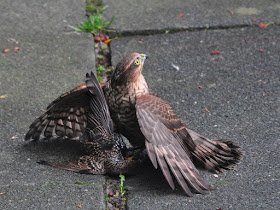The 3rd and 4th may have been a bit windy but I managed to find enough shelter in some of the net rides on the east side of the site at Billinge. These net rides were sheltered from the worst of the stiff westerlies by higher ground, including the hill summit, and tree/shrub cover provided the additional shelter required. Unsettled conditions can produce interesting birding with some birds being held up or forced down by the weather and others battling through and the only way to find out is to get out there.
The first bird caught on both days was a Song Thrush and the greyer tones and slightly smaller size of both suggested they were of continental origin. There were a decent number of Goldcrests present and 19 were ringed over the two sessions. Many of the Goldcrests were carrying quite a bit of fat with 8 weighing 5.8g or more and the two heaviest birds weighed in at 6.3g. Birds in this weight range are carrying more than enough fat to fly to southern England in a single non stop night flight and some may even go on to winter in France. Interestingly, a recovery report showing a movement of one of this autumn's Goldcrests came through just the other day, it was ringed on 2nd September and found dead 18 days later in Hampshire, 267km SSE of Billinge. Full details of this and some other recoveries will be posted in due course.
A Stonechat that suddenly appeared on a fence line on the 3rd was the first of the autumn but it didn't linger and quickly moved on. There was a bit of movement overhead despite the strength of the wind and showed how strong the urge to migrate can be. Meadow Pipits and Chaffinches were the most numerous species on the move but a few Lesser Redpolls were also heading south and 4 were caught. One of the Lesser Redpolls had a bit of a pink flush to some of the breast feathers and it almost had me thinking it was a male for a second, but on further examination it was obviously an adult and didn't have any pink in the cheeks or on the rump, concealed or otherwise, which ruled out the possibility of it being a male.
It isn't always appreciated that adult female Lesser Redpolls can have pink feathers on the breast and or rump in addition to those that are more commonly present on the cheeks. However, the pink, when present, is never quite as strong or as extensive as it is in adult males and is usually only noticeable at very close range (generally arms length or less). It is all too easy to rely on the sexing criteria that are given in Svennson and forget some of the other literature that has been produced and younger ringers may not even be aware of some of it. A very useful paper on the subject was published back in 1981, link here: M. Boddy (1981) Ageing and sexing British lesser redpolls, Ringing &Migration, 3:4, 193-202, DOI: 10.1080/03078698.1981.9673780
 |
| Adult female Lesser Redpoll. The pink centres to some of the breast feathers aren't as obvious in the photograph as they appeared in the hand but you can still see they are there. |
 |
| A side view of the same adult female Lesser Redpoll. |
One of the other Redpolls that was caught was interesting for not having a red poll. There was a slight amber cast to some of the feathers of the fore-crown but it was only very slight. This pigment variation is fairly uncommon but individuals like this do crop up from time to time although the poll is usually a bit more yellow or amber than it was in this case. While this is a first year bird it is trait that I have seen in adults too and I suspect it is more common in females, although it obviously makes sexing birds very difficult outside the breeding season.
 |
| Lessser Redpoll without a red poll 03/10/17 |
 |
| The amber coloured cast to the poll is there but it was very slight and barely noticeable in this individual. |
One thing that has been a feature of late September and now early October has been a general lack of Blackcaps and Chiffchaffs. There seems to have been a slightly earlier and more complete departure of these two species, and Blackcaps in particular, with fewer late birds coming through or lingering compared to the last couple of autumns. The more unsettled weather and lack of easterly winds have almost certainly played a part so it will be interesting to see if this trend continues through the remainder of the autumn.
So an interesting couple of mornings and well worth the effort even though the combined total was a relatively modest 46 birds. Species totals (retraps in brackets) for 3rd & 4th October were: Goldcrest 19; Blue Tit 3; Great Tit 2 (1); Coal Tit 3; Chiffchaff (1); Song Thrush 2; Robin 1; Dunnock 2 (1); Chaffinch 6; Lesser Redpoll 4; Reed Bunting 1.






























